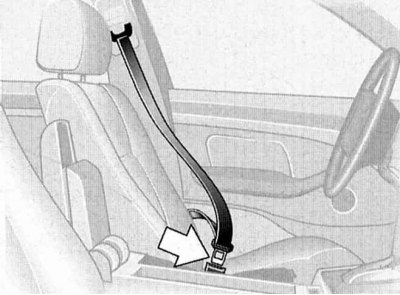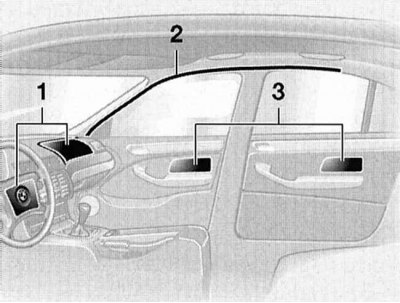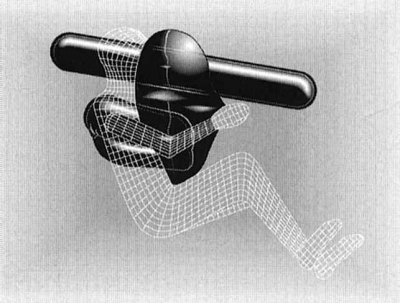Belt tensioner

The belt tensioner ensures a much better fit of the belt to the body during a collision, and allows it to be held securely in the seat. In a fraction of a second, the belt buckle is forced back by gas pressure, simultaneously tightening the diagonal and lap belts. This ensures reliable protection against slipping of a person under the waist belt.
Seat belts

You must fasten your seat belts before every ride.
Fastening: at the moment of fastening, the belt buckle should lock with an audible click.
Release: press the red button and while holding the belt webbing guide it into the retractor.
Belt height adjustment

You can adjust the belt according to your height by adjusting the upper attachment point.
To do this, move the button up or down.
Castle with an inscription "CENTER" only for the seat belt of the passenger seated in the middle of the rear seat.
For your safety, follow the instructions below for the use of the belt, otherwise it will not be able to fully perform its protective function. Be sure to inform all your companions about the need to comply with the rules for using seat belts.
Only one person should wear one seat belt at all times. While the car is in motion, infants and young children must not be kept on the laps of adult passengers. The belt tape should be tightly stretched and fit to the chest and waist without twisting, and under it in the pockets of clothing there should not be hard or brittle objects. The belt should not wrap around the neck. It must not be pinched or rubbed against sharp edges.
The belt should fit as close to the body as possible, so the clothes should not be tight. Tighten the strap around your shoulder more often. Otherwise, in a frontal collision, a loose lap belt may slip up over the thighs and injure the lower abdomen. Due to the increased gap between the belt and the body, the holding effect of the belt is realized with a delay.
Pregnant women should always fasten their seat belts, making sure, in particular, that the lap belt covers the hips from below and does not put pressure on the stomach.
Child Safe Transport Systems*
For children under the age of 12 and less than 150 cm tall, special approved safe transportation systems must be used.
Small children up to 18 months old can be transported in rear-facing carrycots, secured with standard seat belts.
For each age group, the BMW Service Center offers the appropriate child safety systems. When installing these systems, follow the manufacturer's instructions.
Child restraint systems must not be installed in the front passenger seat, otherwise injury may result if the airbag deploys.
It is unacceptable to make changes to the design of child transport systems, otherwise they will not be able to fully fulfill their protective function.
Integrated child seats*

These two child seats, integrated in the outer rear seats and complying with the requirements developed based on the UN Economic Commission for Europe Directive R-44, are intended for children from 3.5 to 12 years old (from 15 to 36 kg).
For children from 18 months to 3.5 years (from 9 to 18 kg) these seats must be used in combination with the special backrest and safety table available from a BMW workshop.
Seat extension:
Grasp the front of the rear seat and pull it up and back slightly as shown by the arrow. Then push the seat back until it clicks into place.
Seat down:

Grasping the loop, pull forward and down as shown by the arrow. Then press down on the seat from above until it clicks into place.
Integrated child seats should only be used if the vehicle is equipped with head restraints.
When adjusting the front seats, make sure that children's legs do not get caught.
Never leave children unattended in a car, even if they are in child seats.
Observe the instructions for using seat belts above in this Section, otherwise they will not be able to perform their protective function.

If the seat belts are damaged or after an accident, contact a BMW Dealer to have the integrated child seat replaced and, if necessary, other accessories.
Locking children in the car

Slide down the latch located on the rear door. Now this door cannot be opened from the passenger compartment.
Airbags (NPB)

1. Front airbags for driver and passenger.
2. Top airbags for head protection (above the front seats).
3. Side airbags (front and rear* seats).

Inertial sensors continuously monitor the acceleration forces acting on the vehicle. If, as a result of a collision, the driver and passenger are subjected to such an acceleration force that the seat belts alone can no longer provide sufficient protection, the airbag inflators for the driver and front passenger are triggered in parallel with each other. However, the front passenger airbag is only activated if the sensor in the seat detects that someone is actually sitting on it.
In the event of a side collision, the head airbag and the front or rear* side airbags will be activated if necessary.
The airbags, which are located under appropriately marked safety linings, deploy, filling with gas in a few milliseconds. At the same time, they tear or squeeze out the safety lining in predetermined places.
Rapid deployment, which is necessary for the normal operation of the airbag, is accompanied by an ignition pop and inflation noise, which, however, are simply not perceived against the background of an accident. The gas required to inflate the airbag does not pose any danger and after a while escapes along with the resulting smoke.
The whole process develops in a fraction of a second.
Protective action
The front airbags protect the driver and front passenger in a frontal collision where the protection provided by the seat belts alone is not sufficient. Top and side airbags provide protection in side impacts. The side airbags protect the respective side chest pieces.

The illustration shows the main directions of impacts to which the airbag reacts.
Airbag control lamp
The lamp indicates that the airbag system is ready for operation already after turning the ignition key to position 1.
The system is ready to go: The control lamp lights up for a while, after which it goes out.
The system is faulty: The control lamp does not light up.
The control lamp, having lit up for a short while, goes out and lights up again.
In the event of a system malfunction, there is a danger that in a collision it will not work, even if the accident is severe enough.
Have the system checked by a BMW workshop immediately.
For your own safety, follow the instructions below regarding the airbags, otherwise they will not be able to fully perform their protective function. Be sure to inform all your companions of the need to follow the instructions regarding airbags.
The presence of airbags does not relieve you of the need to fasten your seat belt, since airbags are only one of the safety features. In minor accidents, vehicle rollovers and impacts to the rear of the airbag, it is not necessary to operate the airbags. You will be protected only by a seat belt.
Sit in the seat as you feel comfortable, but at the same time as far as possible from the steering wheel, front panel or door.
Always hold the steering wheel by the rim. If the airbag is activated, failure to follow this rule may result in injury to the hands or forearms.
There must be no foreign objects between the airbag and the person it protects. The airbag cover for the front passenger cannot be used as a storage shelf.
The safety lining of the steering wheel, front panel and side upholstery of the front and rear doors, as well as the pillars of the lid and the edges of the roof lining must not be pasted over, fitted or somehow modified.
It is unacceptable to reinforce child safety systems in the front passenger seat. Children under 12 years of age and less than 150 cm tall are only allowed in the rear seat.
When equipping the vehicle with side airbags in the rear, make sure that the child seat is installed correctly and at the maximum distance from the door. Do not allow children to lean off the seat towards the airbag, as serious injury may result if the airbag deploys.
Even if all instructions are followed, under certain circumstances, injuries to the face, hands and forearms due to the deployment of airbags cannot be ruled out. For sensitive passengers, the firing pop and noise during airbag inflation can cause short-term hearing loss.
